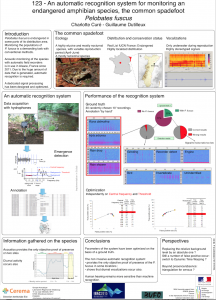Dans le cadre de l’étude acoustique menée sur le Pélobate brun en Alsace, le CEREMA a réalisé un poster présentant l’intérêt de la mise au point d’une technique de suivi de l’espèce grâce à l’enregistrement de ces chants. Ce poster a été présenté au congrès international de la bioacoustique qui s’est déroulé à Murnau début septembre.
An automatic acoustic recognition system for monitoring an endangered amphibian species, the common spadefoot Pelobates fuscus.
Charlotte Curé1, Guillaume Dutilleux1.
1Cerema, Dter Est, Laboratoire Régional de Strasbourg, Groupe Acoustique, 11 rue jean Mentelin, 67035, Strasbourg cedex 2, France.
Abstract :
Acoustic recordings of animal sounds provide an effective tool for monitoring acoustically active species and species which are difficult to observe in the wild such as most anuran species. Automated acoustic recordings allow to collect sounds for extended periods, increasing the probability of detecting a given species with little disturbance to the vocalizing animals. This method implies the processing of a huge acoustic dataset, which can be done manually by listening to the collected acoustic recordings, which represents a very long and tedious work. The aim of our study was to get rid of this operator-dependant processing of the acoustic data and to develop an automatic acoustic recognition system for monitoring the common spadefoot toad (Pelobates fuscus), an amphibian species threatened in France. Automated acoustic recordings were carried out in pools of different locations throughout four successive annual breeding seasons. A routine was developed on Scilab to automatically detect the spadefoot calls in the collected acoustic recordings. The recognition system was based upon i) inspection of the frequency band corresponding to spadefoot call frequencies carrying the highest amplitudes and ii) difference of sound levels between this frequency band and the background noise. Best configuration of the system retained a signal as being a common spadefoot toad call if the maximum sound level, calculated in the 566 – 1131Hz frequency band (octave band with a 800 Hz center frequency), exceeded the average sound level of the background noise of +14dB. This system showed 52% of true positives and 5.4% of false positives, providing a reliable method compared to existing anuran automatic detectors. Using this system, we explored temporal variation in the spadefoot calling activity throughout the breeding season and found that beside the typical and expected nocturnal vocal pic activity of the species, a diurnal period of calling was also present.

